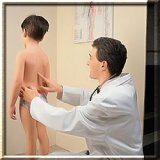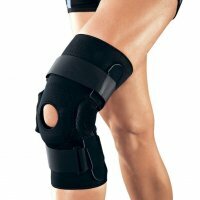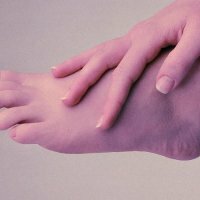Hip joint replacement: all about surgery
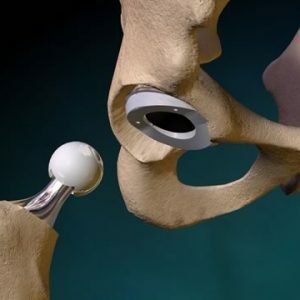
The hip joint is the largest in the body.He has a huge load.In its structure, it is a classic hinge, the main elements of which are the head of the femur and the acetabulum of the pelvic cavity.All articular surfaces are normally covered with cartilaginous tissue, and the synovial fluid fulfills the lubrication function.There are a number of diseases that cause constant pain and a sharp restriction of mobility in the joint.
These symptoms disrupt the habitual rhythm of life and lead to disability and even disability.In the event of such problems, it is recommended not to postpone the visit to the traumatologist-orthopedist, who will conduct a general examination and send for radiography.Based on the results of the data obtained, the question of hip joint prosthetics may be raised.
Table of contents: When is the endoprosthesis installation shown?Preoperative period Hospitalization Surgery for endoprosthetics Types of endoprostheses Postoperative period Restoration and rehabilitationWhen is the endoprosthesis shown?
The tasks of endoprosthetics are to eliminate the pain syndrome and restore the lost functions of the lower limb .Often this serious operation remains the only way to improve the patient's quality of life.
Indications for prosthetics:
- coxarthrosis;
- joint dysplasia;
- fracture of the femoral neck;
- osteonecrosis of the head of the thigh;
- arthritis.
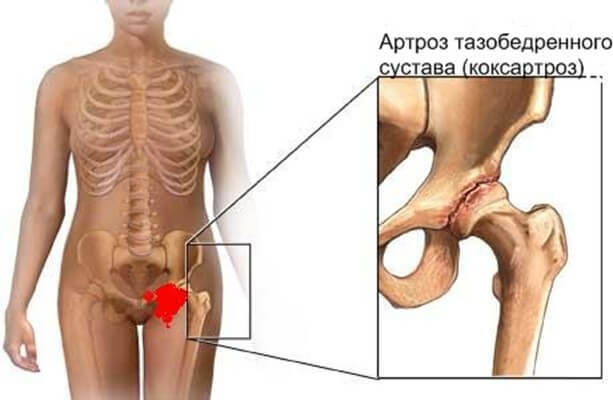
Deforming osteoarthrosis of the hip joint( coxarthrosis) is a disease characterized by the destruction of cartilaginous tissue, resulting in decreased mobility and the development of an intense pain syndrome.The main predisposing factors are the worsening of trophism on the background of insufficient local blood circulation, excessive physical exertion and chronic inflammatory process.In addition to thinning cartilage, as a rule, a decrease in the volume of synovial fluid is determined.In severe cases, the patient is deprived of the opportunity to move without assistance.Pathology is more often diagnosed in the elderly.
Note: arthrosis can be the result of a serious injury.It often develops if the bones after the fracture are fused incorrectly.
Dysplastic coxarthrosis is caused by congenital abnormal development of joint tissues - in particular, the acetabular basin of the pelvis.Dysplasia is a common cause of dislocation.
Fracture of femoral neck is one of the most serious injuries of bone tissue.The main predisposing factor is osteoporosis.Against this background, even a relatively small load causes the fractures of the thinnest portion of the femur.In the elderly, they, as a rule, no longer grow together.
The victim is confined to bed, which leads to a significant deterioration in the overall condition, development and worsening of chronic diseases.In such cases, endoprosthetics become the only possible way to put a person on their feet and, in fact, save his life.
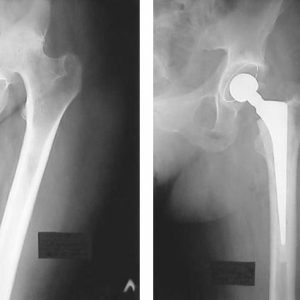 One of the unconditional bases for hip replacement is aseptic necrosis( necrosis) of the head of the femur bone on the background of circulatory disturbances.
One of the unconditional bases for hip replacement is aseptic necrosis( necrosis) of the head of the femur bone on the background of circulatory disturbances.
Arthritis( inflammation of the joints) in some cases have an autoimmune( eg, rheumatic) origin.There are also psoriatic and gouty arthritis.Complications of the pathological process often cause the deformation of articular surfaces, and, as a consequence, a decrease in the amplitude of movements and severe pain.
Preoperative period
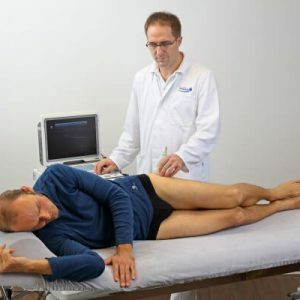 The preparation period for endoprosthetics begins several weeks before the surgery itself.
The preparation period for endoprosthetics begins several weeks before the surgery itself.
After verification of the diagnosis, the patient needs to undergo a complete examination( outpatient or clinic), which includes a number of laboratory tests.It is required for the detection of chronic diseases, in particular - hypertension, diabetes mellitus and bleeding disorders.The data are necessary for the optimal selection of dosages of drugs that will be administered during the intervention and in the postoperative period.In some cases, preliminary treatment of accompanying pathologies may be necessary.
Important: to facilitate the use of walkers and crutches during recovery and rehabilitation, you need to learn how to use them in advance.It is recommended to give increased attention to training the muscles of the arms and trunk.
When the weight is significantly higher than the norm, the patient needs to take measures to reduce it, so that after the operation the load on the endoprosthesis was less.
It is of great importance to have an objective assessment of the patient's needs for home care.It is important to consider that in any case there will be problems with self-service for a while.
If, in the opinion of the surgeon during the intervention, blood transfusion may be required, the patient's own blood for freezing and transfusion, if necessary, is considered. If it is not possible to obtain material for autologous transfusion, blood suitable for the group and Rh factor can be handed over to relatives.
Please note: blood from any donor is carefully checked for viruses!
To prevent postoperative complications, it is important to undergo sanation of chronic foci of infection - in particular carious teeth.The probability of entering pathogenic bacteria in the bloodstream is small, but it must still be taken into account.
If the patient regularly takes certain pharmacological drugs, the question of their temporary cancellation may be raised.
Smokers need to give up the bad habit, since it has the most negative effect on the blood vessels and is one of the reasons for the development of thrombosis.
Hospitalization
 A patient is usually placed in a hospital on the eve of an upcoming operation.The attending physician again conducts an examination, checks the data of laboratory tests and prepares documents for hospitalization.
A patient is usually placed in a hospital on the eve of an upcoming operation.The attending physician again conducts an examination, checks the data of laboratory tests and prepares documents for hospitalization.
Important: hip joint endoprosthetics can be performed free of charge if there are quotas for the federal high-tech medical care program.
With the patient, the plan of the operation is necessarily discussed.After the conversation, the patient signs informed consent for surgical treatment.With the direct participation of an anesthetist, the type of anesthesia is determined.Intervention is performed either under anesthesia( introductory intravenous or mask + endotracheal), or under spinal or epidural analgesia.
On the eve of the operation, you can eat as usual, but after 18-00 from eating you need to refrain.The liquid can be taken until midnight.
Important: alcoholic drinks per day before operation are completely excluded!
It is desirable that the patient takes a shower on the eve or in the morning before the intervention.It is advisable to use soap with antibacterial components for hygienic procedures.
In the morning, he needs to brush his teeth and rinse out the mouth, but do not swallow water.The liquid or food in the stomach can provoke vomiting with aspiration( ingestion of gastric contents in the respiratory tract).
Surgery for endoprosthesis
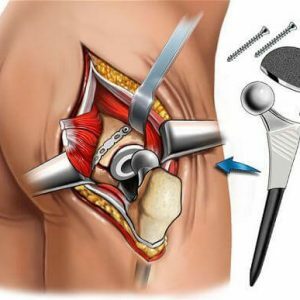 To prevent thrombosis, a compression bandage( elastic bandage or stocking) is applied to the opposite lower limb.
To prevent thrombosis, a compression bandage( elastic bandage or stocking) is applied to the opposite lower limb.
To avoid fear and anxiety, premedication is performed.The patient is injected with a sedative( for example, a phenazepam solution).In the operating room it is delivered on a special gurney.
After initial anesthesia, the patient undergoes intubation, i.e., a tube is inserted into the respiratory tract and connected to the ventilator.Sensors are connected to the body transmitting data on arterial pressure, cardiac and respiratory rhythm and temperature to a special monitor.The indicators are constantly monitored by an anesthesiologist-resuscitator.A catheter is inserted into the bladder;Remove it only on the second day after endoprosthetics.
During surgical intervention, affected by the pathological process, the own joint elements are replaced by artificial structures.Enoprosthesis completely copies the shape of healthy surfaces and allows a person to perform movements in full.
To improve the outflow of exudate, a drainage tube may be placed during the suturing( or overlapping of the braces on the edges of the wound).
Endoprosthesis types
High-tech materials are used in the manufacture of endoprostheses - modern metal alloys, polymer compounds and ceramics.They are characterized by excellent survival( biocompatibility) and the highest mechanical strength, and provide a completely painless and smooth movement.The average life of the structures is 15-20 years or more.After this time, replacement of worn artificial components with new ones is shown.
Modern hip joint prostheses by type of fixation are divided into two main types:
- cement fixation;
- cementless fixation.
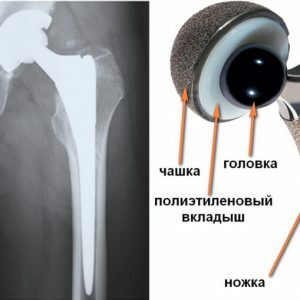 Implants of the first variety, as the name implies, are attached to the stored own fabrics using a special cement.Fixation of the second is provided by a special texture of the surface, into which the bone tissue eventually grows.
Implants of the first variety, as the name implies, are attached to the stored own fabrics using a special cement.Fixation of the second is provided by a special texture of the surface, into which the bone tissue eventually grows.
If the destruction of the cartilage of the joint is diagnosed, and the head of the femur has not undergone pathological changes, the so-called.A cap-shaped structure, corresponding to the normal joint surface.This endoprosthesis allows you to keep your own healthy tissue.After the operation, the patient is able to perform the movements in full.
Total prosthetics involves the installation of biocompatible implants with fixation in the acetabulum and femur.
Postoperative period
Depending on the type of anesthesia used and the general condition of the person, at the end of the operation, it is transferred to the intensive care unit or returned to a normal ward.
Periodically measured vital signs - temperature and blood pressure.Under the supervision of the attending physician, regular sterilization of dressings covering the postoperative wound and parallel treatment of the joint with antiseptic solutions is performed regularly( usually daily after the morning detour).
Important! For the prevention of infectious complications for 3 days intramuscularly injected drugs from the group of antibiotics of a wide range of action.
If necessary, blood transfusion is performed.Most patients are treated with drugs that improve the rheological properties of the blood.This helps to prevent thrombus formation.
It is allowed already by the evening of the day.It is recommended to eat in small portions, and liquid - in small sips, so that nausea does not appear.
Before the hygienic procedures( shower) before the removal of the joints, i.e. within a half to two weeks, the postoperative wound should be closed with a waterproof insulating bandage.
Rehabilitation and rehabilitation
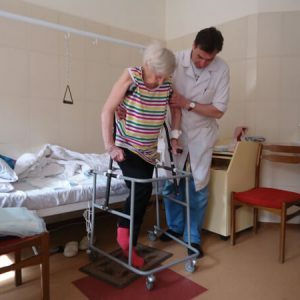 In the early days, a bed rest is shown with the possibility of performing active movements;To sleep the patient is necessary on the back.In order to prevent the trophosis of the veins, the limbs are bandaged with an elastic bandage.At the initial stages of recovery, it is not recommended to avoid large amplitude movements in the operated hip, as well as the knee joint.
In the early days, a bed rest is shown with the possibility of performing active movements;To sleep the patient is necessary on the back.In order to prevent the trophosis of the veins, the limbs are bandaged with an elastic bandage.At the initial stages of recovery, it is not recommended to avoid large amplitude movements in the operated hip, as well as the knee joint.
When fixing the endoprosthesis on cement, the metered loads are allowed from the first days, and complete ones - by the end of the first month after surgical treatment.
If cementless installation of the structure is carried out, then it is allowed to transfer 15% of the body weight to the operated limb, after a week or one and a half.50% of the weight is the allowable load from the end of the 3rd week.To transfer 100% of the body weight( i.e., for some time to stand on one leg) can be 2 months after the implant is installed.
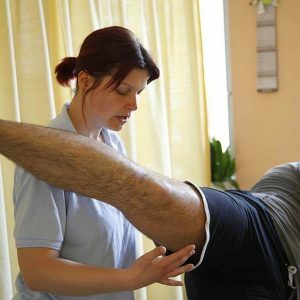 To improve blood circulation, reduce swelling and accelerate the regeneration of tissues, exercise therapy is indicated.Dosed physical exertion is also necessary for the speedy recovery of the volume of movements in the hip joint and strengthening of the musculature of the foot.
To improve blood circulation, reduce swelling and accelerate the regeneration of tissues, exercise therapy is indicated.Dosed physical exertion is also necessary for the speedy recovery of the volume of movements in the hip joint and strengthening of the musculature of the foot.
For 3-4 weeks gymnastic exercises are carried out in bed, and then they can be performed while standing.Selection of the optimal complex of exercise therapy is the task of a specialist in rehabilitation.
Plisov Vladimir, medical reviewer

